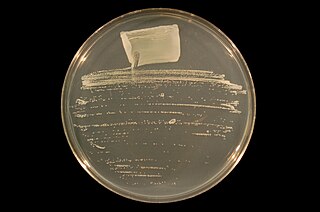Related Research Articles

Thermus is a genus of thermophilic bacteria. It is one of several bacteria belonging to the Deinococcota phylum. Thermus species can be distinguished from other genera in the family Thermaceae as well as all other bacteria by the presence of eight conserved signature indels (CSIs) found in proteins such as adenylate kinase and replicative DNA helicase as well as 14 conserved signature proteins (CSPs) that are exclusively shared by members of this genus.
The Aurantimonadaceae are a small family of marine bacteria.

Campylobacterota are a phylum of bacteria. All species of this phylum are Gram-negative.

Ensifer is a genus of nitrogen-fixing bacteria (rhizobia), three of which have been sequenced.
Halopiger is a genus of archaeans in the family Natrialbaceae that have high tolerance to salinity.
Thermoanaerobacter is a genus in the phylum Bacillota (Bacteria). Members of this genus are thermophilic and anaerobic, several of them were previously described as Clostridium species and members of the now obsolete genera Acetogenium and Thermobacteroides
Agrococcus is a genus in the phylum Actinomycetota (Bacteria).
Desulfosporosinus is a genus of strictly anaerobic, sulfate-reducing bacteria, often found in soil.
Virgibacillus is a genus of Gram-positive, rod-shaped (bacillus) bacteria and a member of the phylum Bacillota. Virgibacillus species can be obligate aerobes, or facultative anaerobes and catalase enzyme positive. Under stressful environmental conditions, the bacteria can produce oval or ellipsoidal endospores in terminal, or sometimes subterminal, swollen sporangia. The genus was recently reclassified from the genus Bacillus in 1998 following an analysis of the species V. pantothenticus. Subsequently, a number of new species have been discovered or reclassified as Virgibacillus species.
Erythrobacteraceae is a bacterium family in the order of Sphingomonadales.
Kaistia granuli is a Gram-negative, chemoorganotrophic, non-spore-forming, rod-shaped and non-motile bacterium from the genus of Kaistia which has been isolated from sludge from a wastewater treatment plant in Gongju in Korea.
Olivibacter is a genus from the family of Sphingobacteriaceae.
Roseivirga is a strictly aerobic genus from the phylum Bacteroidota.
Desulfotignum is a Gram-negative and strictly anaerobic bacteria with a single polar flagellum genus from the family of Desulfobacteraceae.
Aeromicrobium is a Gram-positive, aerobic, non-spore-forming and non-motile bacterial genus from the family of Nocardioidaceae.
Patulibacter is a genus of bacteria from the family Patulibacteraceae.
Solirubrobacter is a Gram-positive, spore-forming, aerobic, mesophilic and non-motile genus of bacteria from the family Solirubrobacteraceae.
Anaerolineaceae is a family of bacteria from the order of Anaerolineales. Anaerolineaceae bacteria occur in marine sediments. There are a total of twelve genera in this family, most of which only encompass one species. All known members of the family are Gram-negative and non-motile. They also do not form bacterial spores and are either mesophilic or thermophilic obligate anaerobes. It is also known that all species in this family are chemoheterotrophs.
Dyella is a genus of bacteria from the family of Rhodanobacteraceae. Dyella is named after the New Zealand microbiologist Douglas W. Dye.
Pseudoruegeria is a genus of bacteria from the family of Rhodobacteraceae.
References
- 1 2 3 4 5 Parte, A.C. "Kaistia". LPSN .
- ↑ Hördt A, García López M, Meier-Kolthoff JP, Schleuning M, Weinhold LM, Tindall BJ, Gronow A, Kyrpides NC, Woyke T, Göker M (2020). "Analysis of 1,000+ Type-Strain Genomes Substantially Improves Taxonomic Classification of Alphaproteobacteria". Front. Microbiol. 11: 468. doi: 10.3389/fmicb.2020.00468 . PMC 7179689 . PMID 32373076.
- ↑ "Kaistia". www.uniprot.org.